You’re trying to build an amazing adult toy brand, but material choices are tricky, right? Pick wrong, and you could face returns, bad reviews, or even safety issues. It’s a decision that really matters.
Generally, platinum-cured silicone is superior for body safety, durability, and hygiene, making it ideal for premium toys. TPE offers lower costs and diverse, often softer textures, suitable for budget lines or specific sensations, but requires very careful sourcing for safety.
Hey folks, Jerry Zou here, founder of PrivyPlay. Over my years in manufacturing and specifically in the adult products sector, the "silicone or TPE?" question has come up countless times. It’s not just a simple preference; it’s a strategic decision for your brand. Whether you’re an e-commerce entrepreneur, a purchasing manager for a wellness brand, or a boutique owner, the materials you choose speak volumes about your commitment to quality and your customers’ well-being. At PrivyPlay, our slogan is "Elevating Pleasure, Empowering Confidence," and material choice is fundamental to that. So, let’s break down these two popular options. I’m going to share what I’ve learned from my experience, the good, the bad, and the sometimes surprising.
Which Material Wins on Body Safety and Hygiene?
This is probably the BIGGEST question for any responsible brand. You want products that customers trust implicitly. So, when it comes to safety and cleanliness, how do silicone and TPE really compare?
Platinum-cured silicone is the clear winner for body safety and hygiene. It’s non-porous, hypoallergenic, and free from harmful chemicals like phthalates. TPE can be body-safe, but quality varies wildly, and it’s generally more porous.
Okay, let’s get right into it. When we talk about body safety in adult toys, platinum-cured silicone is pretty much the gold standard. And there’s a good reason for that! This type of silicone is incredibly pure. It’s non-porous, which is a huge deal. Think about it: non-porous means there are no microscopic nooks or crannies for bacteria or mold to hide and grow. This makes cleaning super effective – soap and water, or a good toy cleaner, and you’re set. Many high-quality silicone toys can even be boiled for complete sterilization! That’s a massive plus for hygiene-conscious consumers. Plus, platinum-cured silicone is generally hypoallergenic and doesn’t contain nasty stuff like phthalates, BPA, or latex. These are things we actively avoid at PrivyPlay because they can cause irritation or worse.
Now, TPE (Thermoplastic Elastomer) is a different beast. Can it be body-safe? Yes, some TPEs can be. But – and this is a big "but" – the quality and composition of TPE can vary enormously between suppliers. You must ensure you’re sourcing medical-grade or food-grade TPE that is certified phthalate-free. The problem is, cheaper TPEs might not be, and they can also be more porous than silicone. More porosity means more potential for bacteria to linger, even after cleaning. It’s one of the reasons we’re so stringent with our TPE sourcing if we ever consider it for a product. Honestly, for any toy intended for internal use, my strong preference is always for platinum-cured silicone. The peace of mind is just invaluable for us and for our clients.
What’s the Real Difference in Feel and Texture?
Beyond safety, how a toy feels is paramount for customer satisfaction. People are looking for specific sensations. So, can TPE offer a more "realistic" or varied experience than silicone?
TPE often excels in creating very soft, squishy, and skin-like textures, which many find realistic. Silicone typically offers a smoother, silkier feel, though modern formulations can also achieve good softness and unique finishes.
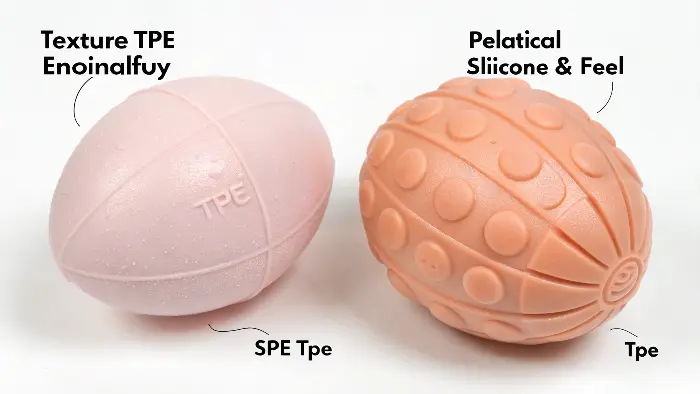
This is where TPE can really shine and why it’s popular for certain types of products. TPE is incredibly versatile in terms of softness and texture. Manufacturers can formulate TPE to be extremely soft, almost jelly-like, or firmer, and it often has a slightly tacky or "grippy" quality that can feel very much like human skin. This "real feel" is a big selling point for products like realistic dildos, masturbators, or sleeves. I’ve handled some TPE products that are astonishingly lifelike in their squishiness and give! You can also achieve dual-density with TPE relatively easily – a firmer core with a super-soft outer layer, for instance.
Silicone, on the other hand, tends to have a smoother, silkier, often more velvety feel. It glides beautifully, especially with a good water-based lubricant. While traditional silicone was often perceived as being quite firm, modern advancements mean you can get very soft, pliable silicone too. We at PrivyPlay have worked with some fantastic new silicone formulations that offer incredible softness without compromising on the hygienic benefits. For example, our [‘CloudNine’ G-Spot Vibrator – placeholder name] uses a specially developed soft-touch silicone that customers rave about. So, it’s not that one is universally "better" in feel. It depends on the desired sensation for the specific product. If you’re going for ultimate realism and a fleshy feel, TPE might have an edge. If you want silky smoothness, durability, and premium hygiene, silicone is usually the way to go. Sometimes, a brand might even offer both to cater to different preferences.
How Do They Compare in Durability and Longevity?
Customers expect their purchases to last. No one wants a toy that tears, degrades, or becomes sticky after a few uses. So, which material holds up better over time and with regular cleaning?
Silicone is significantly more durable and long-lasting than TPE. It’s heat-resistant, doesn’t easily tear or degrade, and maintains its integrity through proper cleaning. TPE is generally more prone to wear, tearing, and degradation from oils or improper care.
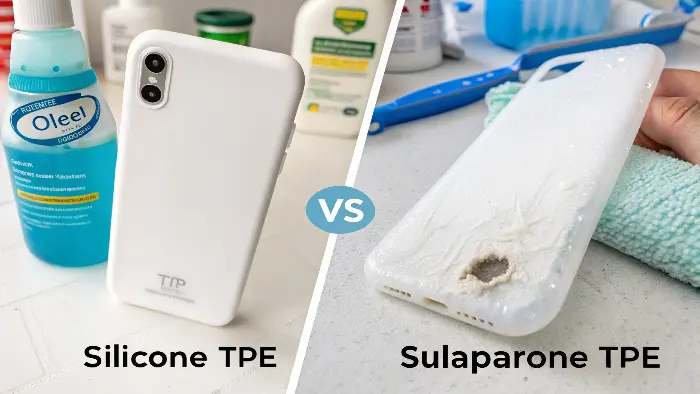
When it comes to standing the test of time, silicone definitely takes the crown. High-quality, platinum-cured silicone is a remarkably resilient material. As I mentioned, it’s heat resistant. This means it can be boiled for sterilization without damage. It also means it won’t warp if accidentally left in a warm car (though I don’t recommend that!). Silicone doesn’t easily tear, and it doesn’t tend to absorb oils or colors, so it’s less likely to stain or degrade from contact with various substances (except silicone-based lubes, more on that later!). A well-cared-for silicone toy can last for many, many years. I still have some prototype silicone toys from years ago that are in perfect condition!
TPE, unfortunately, is generally not as robust. Softer TPE formulations, in particular, can be prone to tearing, especially around thinner sections or detailed areas. It’s not heat resistant, so boiling is a no-go, and even hot water might be too much for some TPEs. A big issue with TPE is its susceptibility to oils and certain chemicals. Some body oils, oil-based lubricants, or even harsh soaps can cause TPE to break down, become sticky, or even melt over time. I’ve seen TPE toys turn into a gummy mess because of improper storage or cleaning. This means TPE toys require more careful handling and have a shorter lifespan on average. For us at PrivyPlay, offering products that last is part of "Empowering Confidence." A customer who invests in one of our silicone toys knows they’re getting something built for the long haul.
Are There Significant Cost and Manufacturing Differences?
As a brand owner or sourcing manager, the bottom line always matters. So, from raw materials to factory floor, what are the cost implications and manufacturing realities of silicone versus TPE?
TPE is generally less expensive in terms of raw material cost and can be faster and easier to process via injection molding, often leading to lower unit costs and potentially faster production times than premium silicone.
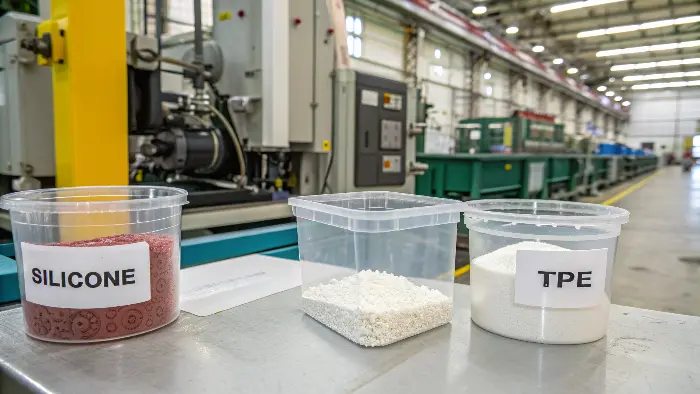
This is an area where TPE often looks attractive, especially for brands targeting a lower price point or needing high-volume, fast turnaround. The raw material cost for most TPE formulations is typically lower than that of high-grade platinum-cured silicone. That premium, medical-grade silicone we prefer at PrivyPlay definitely comes at a higher price point. Beyond materials, TPE is often quicker and easier to process in a factory setting. It’s well-suited to standard injection molding, which can have very fast cycle times. This means more units can be produced in a shorter period. Silicone molding, especially compression molding for solid parts or liquid silicone rubber (LSR) injection molding, can be more complex, require more specialized (and sometimes more expensive) tooling, and often has longer cycle times. These manufacturing efficiencies for TPE can translate to lower Minimum Order Quantities (MOQs) from some factories and a lower ex-factory price per unit. When I first started exploring different product lines, the cost-effectiveness of TPE was certainly something I had to consider. However – and this is a really important "however" – chasing the lowest cost with TPE can be risky. As mentioned, TPE quality varies wildly. If you go with an unknown supplier just because their TPE price is rock bottom, you might end up with a product that’s not body-safe, or that degrades quickly. So, while TPE can be more cost-effective to produce, the due diligence required to ensure you’re getting a good quality, safe TPE is much higher, in my experience. You really need a trustworthy manufacturing partner who understands the nuances.
What About Environmental Impact and Sustainability?
Many consumers, and hopefully brands, are thinking more about the planet. It’s a tough one for our industry, but are there any differences between silicone and TPE in terms of their environmental footprint?
Neither material is easily biodegradable. Silicone is very durable, meaning longer product life and less waste. TPE’s recyclability varies greatly; some are recyclable, many aren’t, and lower durability can mean faster replacement.
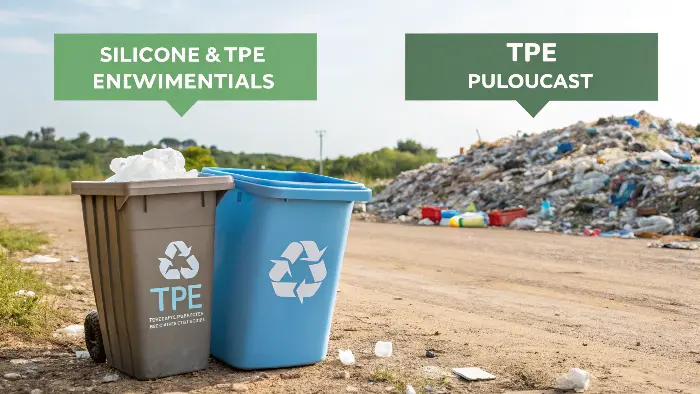
This is a tricky subject, and honestly, there are no perfect answers in the adult toy industry right now when it comes to sustainability. Neither silicone nor TPE are biodegradable in the way a banana peel is. They are both synthetic polymers. However, we can look at it from a "lesser of two evils" or "longevity" perspective. Silicone, being highly durable, means that a good quality silicone toy can last for many, many years. A longer product lifespan means fewer toys end up in landfills over time. That, in itself, is a form of sustainability – buy quality, buy less often. Silicone isn’t easily recycled in most municipal streams; it requires specialized processes.
TPE is a broad family of materials. Some specific types of TPE are technically recyclable, but whether they actually get recycled depends on local facilities and the specific TPE formulation. Many TPE adult toys, especially the cheaper ones, are likely not made from easily recyclable grades, or they are blends that complicate recycling. And, as we discussed, if TPE toys are less durable and need to be replaced more frequently, that arguably creates more waste, even if the material could theoretically be recycled. At PrivyPlay, we focus on making our silicone products as durable as possible. We also try to use minimal, recyclable packaging. It’s an ongoing challenge for the whole industry. I think the best approach right now is to prioritize high-quality, long-lasting materials to reduce the overall consumption and disposal cycle. It’s something I’m always discussing with my suppliers – how can we be better?
How Does Lubricant Compatibility Differ Between Silicone and TPE?
This is a super practical point! Using the wrong lube can literally destroy a toy, leading to a very unhappy customer. So, what’s the golden rule for lubes with silicone and TPE?
Silicone toys demand water-based lubricants ONLY; silicone-based lubes will degrade silicone. TPE toys are safest with water-based lubes; oil-based and often silicone-based lubes can damage many TPE formulations.
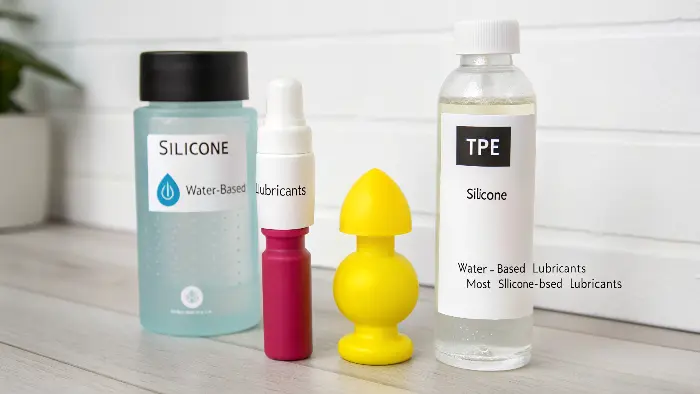
Lubricant compatibility – oh boy, this is a big one and a common source of customer mishaps! Get this wrong, and it’s bad news for the toy and your brand’s reputation.
For silicone toys, the rule is simple and absolute: ONLY use water-based lubricants. Why? Because silicone is, well, silicone. If you use a silicone-based lubricant on a silicone toy, the lubricant can start to break down the surface of the toy. It’s like they’re too similar and they react. The toy can become sticky, gummy, or even start to feel like it’s melting or pitting. This damage is irreversible. I’ve seen beautiful, expensive silicone toys ruined this way. It’s heartbreaking! So, clear customer education is vital here. All our PrivyPlay silicone products come with a strong recommendation for water-based lubes.
For TPE toys, it’s a little more complex, but the safest general advice is also to stick with water-based lubricants. Many TPE formulations are sensitive to oils. So, oil-based lubricants are generally a no-go as they can cause the TPE to swell, degrade, or become overly sticky. What about silicone lubes with TPE? Some higher-quality TPEs might tolerate some silicone lubes, but it’s very formulation-dependent. Given the huge variation in TPEs out there, it’s a bit of a gamble unless the toy manufacturer explicitly states a specific silicone lube is safe. To avoid any issues, we always recommend our customers use water-based lube with any TPE products as well. It’s just the safest, most reliable option to ensure the toy stays in good condition. As a brand, making this information clear on packaging and product listings is crucial for customer satisfaction and product longevity. Trust me, it saves a lot of headaches down the line.
Conclusion
Ultimately, silicone offers superior safety, hygiene, and durability for premium adult toys. TPE provides cost benefits and diverse textures, but demands rigorous sourcing for safety and has a shorter lifespan. Choose wisely based on your brand values.
